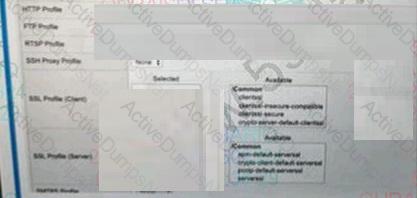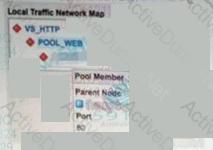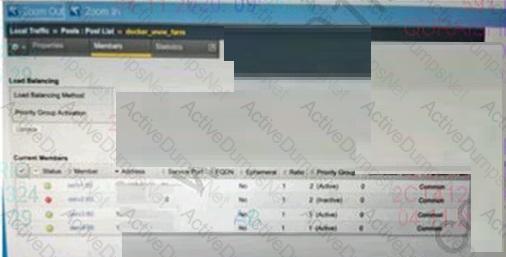F5 201 TMOS Administration Exam Practice Test
TMOS Administration Questions and Answers
A BIG-IP Administrator is unable to connect to the management interface via HTTPS. What is a possible reason for this issue?
A BIG-IP Administrator needs to apply a license to the BIG-IP system to increase the user count from the
base license.
Which steps should the BIG-IP Administrator?
A BIG-IP Administrator needs to collect HTTP status code and HTTP method for traffic flowing through a
virtual server.
Which default profile provides this information?
Which process or system can be monitored by the BIG-IP system and used as a failover trigger in a redundant pair configuration?
During a high-demand traffic event, the BIG-IP Administrator needs to limit the number of new
connections per second allowed to a Virtual Server.
What should the administrator apply to accomplish this task?
You need to terminate client SSL traffic at the BIG-IP and also to persist client traffic to the same pool member based on a BIG IP supplied cookie. Which four are profiles that would normally be included in the virtual
server's definition? (Choose four.)
Refer to the exhibit.

A BIG-IP Administrator configures a Virtual Server to handle HTTPS traffic. Users report that the
application is NOT working.
Which actional configuration is regard to resolve this issue?
How should a BIG-IP Administrator persistent sessions from being sent to a pool member so that the server administrator can perform maintenance?
Refer to the exhibit.

Why is the virtual server responsive to incoming connections?
Which log file should the BIG-IP Administrator check to determine if a specific user tried to log in to the 8IG-IP Configuration by utility?
Given that VLAN failsafe is enabled on the external VLAN and the network that the active BIG-IP's external VLAN is connected to has failed, which statement is always true about the results?
Refer to the exhibit.

Which Pool Members are receiving traffic?
Assume a virtual server has a ServerSSL profile. What SSL certificates are required on the pool members?
Which is an advantage of terminating SSL communication at the BIGIP rather than the ultimate web server?
A BIG-IP Administrator creates a new VLAN on BIG-IP Cluster Member A and attaches an Interface to it. Although the Auto Config Sync is in place, the new VLAN does NOT show up on Cluster Member B. What should the BIG-IP Administrator do to ensure the new VLAN is configured on each Cluster Member?
A BIG-IP Administrator needs to have a BIG-IP linked to two upstream switches for resilience of the external network. The network engineer who is going to configure the switch instructs the BIG-IP Administrator to configure interface binding with LACP. Which configuration should the administrator use?
New Syslog servers have been deployed in an organization. The BIG-IP Administrator must reconfigure the BIG-IP system to send log messages to these servers.
In which location in the Configuration Utility can the BIG-IP Administrator make the needed configuration changes to accomplish this?
A BIG-IP Administrator needs to purchase new licenses for a BIG-IP appliance.
The administrator needs to know if a module is licensed and the memory requirement for that module.
Where should the administrator view this information in the System menu?
Which two methods can be used to determine which BIG-IP is currently active? (Choose two.)
What should the BIG-IP Administrator do to apply and activate a hotfix to a BIG-IP device that is currently running version 11.0.0 on active partition HD1.1?
Which three iRule events are likely to be seen in iRules designed to select a pool for load balancing? (Choose three.)
A node is a member of various pools and hosts different web applications. If a web application is unavailable, the BIG-IP appliance needs to mark the pool member down for that application pool. What should a BIG-IP Administrator deploy at the pool level to accomplish this?
A BIG-IP Administrator needs to install a HotFix on a standalone BIG-IP device, which has HD1.1 as the Active Boot Location. The BIG-IP Administrator has already re-activated the license and created an UCS archive of the configuration. In which sequence should the BIG-IP Administrator perform the remaining steps?
A BIG-IP Administrator defines a device Self IP . The Self IP is NOT reachable from the network. What should the BIG-IP Administrator verify first?
A BIG-IP Administrator must determine if a Virtual Address is configured to fail over to the standby member of a device group in which area of the Configuration Utility can this be confirmed?
The BIG-IP Administrator disable all pool members in a pool Users are still able to reach the pool
members.
What is allowing users to continue to reach the disabled poo! members?
Some users who connect to a busy Virtual Server have connections reset by the BIG-IP system. Pool member resources are NOT a factor in this behavior. What is a possible cause for this behavior?
A BIG-IP has two load balancing virtual servers at 150.150.10.10:80 and 150.150.10.10:443. The port 80 virtual server has SNAT automap configured. There is also a SNAT configured at 150.150.10.11 set for a source
address range of 200.200.1.0 / 255.255.255.0. All other settings are at their default states. If a client with the IP address 200.200.1.1 sends a request to https://150.150.10.10, what is the source IP address when the
associated packet is sent to the pool member?
A Virtual Server uses an iRule to send traffic to pool members depending on the URI. The BIG-IP
Administrator needs to modify the pool member in the iRule.
Which event declaration does the BIG-IP Administrator need to change to accomplish this?
One of the two members of a device group has been decommissioned. The BIG-IP Administrator tries to
delete the device group, but is unsuccessful.
Prior to removing the device group, which action should be performed?
A BIG-IP Administrator upgrades the BIG-IP LTM to a newer software version. After the administrator reboots into the new volume, the Configuration fails to load. Why is the Configuration failing to load?
Refer to the exhibit
The network team creates a new VLAN on the switches. The BIG-IP Administrator needs to create a
configuration on the BIG-IP device. The BIG-IP Administrator creates a new VLAN and Self IP, but the
servers on the new VLAN are NOT reachable from the BIG-IP device.
Which action should the BIG-IP Administrators to resolve this issue?
A BIG-IP Administrator reviews the log files to determine the cause of a recent problem and finds the
following entry.
Mar 27.07.58.48 local/BIG-IP notice mcpd {5140} 010707275 Pool member 172.16.20.1.10029 monitor
status down.
What is the cause of this log message?
A BIG-IP Administrator needs to restore a UCS file to an F5 device using the Configuration Utility. Which section of the Configuration Utility should the BIG-IP Administrator access to perform this task?
Active connections to pool members are unevenly distributed. The load balancing method is Least Connections (member) Priority Group Activation is disabled. What is a potential cause of the event distribution?
An application is configured so that the same pool member must be used for an entire session, as well as for HTTP and FTP traffic.
A user reports that a session has terminated, and the user must restart the session. The BIG-IP Administrator determines that the active BIG-IP device failed over to the standby BIG-IP device. Which configuration settings should the BIG-IP Administrator verify to ensure proper behaviour when BIG-IP failover occurs?
What is required for a virtual server to support clients whose traffic arrives on the internal VLAN and pool members whose traffic arrives on the external VLAN?
An LTM device has a virtual server mapped to www5f.com with a pool assigned. The objects are defined
as follows:
Virtual server. Destination 192.168.245.100.443 netmask 255.255.255.0
Persistence: Source address persistence netmask 255.0.0.0
SNAT:AutoMap
Profiles: HnP/TCP
How should the BIG-IP Administrator modify the persistence profile so that each unique IP address
creates a persistence record?
